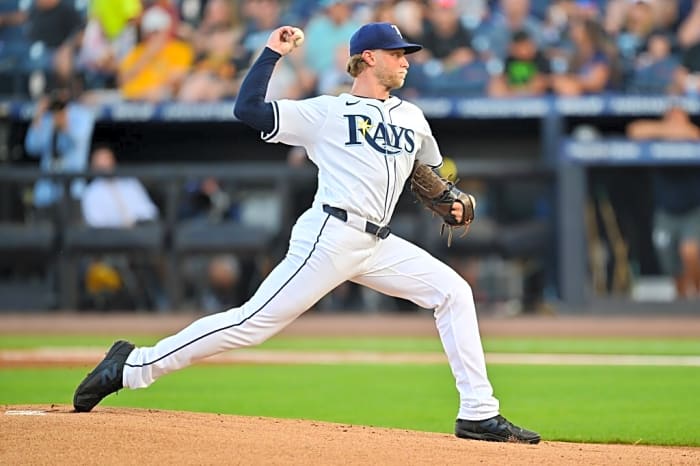
Stats and rankings taken prior to first pitch on April 18.
Shane Baz has had his spotlight swapped with the other Shane in the Tampa Bay Rays‘ rotation (McClanahan) over the past couple of seasons, and rightfully so.
McClanahan dazzled to start his career with back-to-back All-Star appearances in 2022 and ’23, as he led way in the Rays’ talented rotation.
Baz, whom Tampa acquired as part of the Chris Archer deal from Pittsburgh, was a promising prospect who has been limited to 23 starts over the first four years of his professional career due to injury.
Well, now McClanahan is on the shelf, and Baz is back and looking like an ace.
It was never a question of talent for Baz. He was Pittsburgh’s first-round selection in 2017 and earned the top spot in the Rays’ prospect rankings in 2022 after a promising three starts the season prior. When Baz has been healthy, he’s produced. However, staying healthy has been a struggle.
Baz made 14 starts down the stretch last season, pitching to a 3.06 ERA and 4.07 FIP across 79.1 innings. He struggled at times in July and August, but he really rounded into form in September. He made five starts and showed better command, posting a 2.37 ERA for the month.
Baz entered the offseason with momentum, and he rode it right into the 2025 season.
Baz’s Hot Start
If you haven’t watched a Shane Baz start this season, I suggest putting his next outing on your calendar. The level of pitcher we are seeing right now only makes the infamous Chris Archer trade sting that much more in Pittsburgh.
Through three starts, Baz has a 1.42 ERA and 2.15 FIP, all while striking out 12.79 hitters per nine and posting a 1.89 BB/9. Simply put, that’s pure dominance.
We always knew he had the stuff to rack up strikeouts, but after his injury, the numbers took a noticeable dip, going from 10.00 K/9 in 2022 to 7.83 K/9 the year after. Although it was concerning, you could write it off as working back from injury. Thankfully, Baz is now back and healthy, sitting at an insane 12.79 K/9.
The way Baz is getting swing-and-misses is as simple as using his fastball to set up his curveball and changeup. However, his fastball has made a significant jump in velocity from 95.6 mph last season to 97 mph this year. That tick-and-a-half increase is significant, especially when it’s followed by a tumbling 83.8 mph curveball.

Baz has been using his fastball high in the zone in order to set up his curveball. An elevated fastball at 97 mph moves the batter’s eyes; Spin a curveball right off of that fastball, and you can see why batters are struggling to do damage against him. They think another high fastball is coming in until it darts south for the border.
His curveball is holding batters to an .069 average and 34.1% whiff rate. He’s surrendered just two total hits — one was a lucky bloop to third where a slight shift was on against Oneil Cruz, the other was a groundball to third that Ke’Bryan Hayes beat out.
Clearly Baz has found a new primary secondary pitch after his slider held that title previously. Pitchers often work with their pitch mix in order to find what works, but Baz dropping his slider usage from 21.3% last season to 11% in 2025 is a drastic shift.
This could be a case of having a small sample size and him mostly only using his slider against righties, but I think it also speaks volumes about how comfortable and confident he is in his curveball. He’s not afraid to throw it anywhere in the zone and challenges hitters, and none have made him pay for it just yet.
If his slider does turn into a pitch he only uses here and there, like we saw in his last start where he only threw two, I think he can still be successful. A three-pitch mix is enough when you have a 97 mph fastball with nearly 17 inches of IVB, a great curveball, and a well-utilized changeup.
What makes all of this come together is Baz’s ability to command these pitches. Putting them right where he wants to allows each pitch to play up enough and keep batters guessing. He can afford to intentionally throw a ball high and out of the zone to set up his curveball because he continues to work himself into pitcher’s counts.
In fact, Baz has had a pitcher’s count more than an even count or hitter’s count, and he has held batters to an .077/.077/.192 slash line.
Are There Any Concerns Moving Forward?
Okay, okay, I know it cannot all be sunshine and rainbows, right? Well, we aren’t far off from a fairy tail start, but there are a few areas of Baz’s game to at least monitor. Although contact against him has been pretty rare, when batters have made contact with the ball, it has been loud.
So far, Baz is allowing an average exit velocity of 91.1 mph, which is in line with previous years. However, only two of his pitches — fastball and slider — are getting hit hard. His slider, which we already established is his least-used pitch, is the only pitch Baz has given up a home run on, and he’s done so twice.
Fastballs are usually going to result in harder contact, but this is where Baz could run into some trouble. At times, he’s been susceptible to the long ball, and it often comes back to his fastball getting pelted. This isn’t necessarily new for Baz, and he’s been able to manage in the past, so I have hope moving forward.
Also, considering how lethal it looks, a higher usage of his curveball should help keep hitters off balance, even if it is just enough to cause those hard-hit balls to not be squared up.
It sounds simple, but that can be the difference maker. If you watch some of the at-bats against Baz this year, you will notice how uncertain batters look as each pitch comes buzzing in.
Of course, we have to talk about injury risk. At this point, I’m truly not sure how much concern to have about pitchers and their injury history. Everyone seems to go through some variation of elbow or shoulder ailments in their career. But, increased velocity and spin rates that are in line with expectations tell me there shouldn’t be any greater concern than other pitchers.
Final Thoughts
The Rays often find ways to get the most out of their players, no matter the skill level. An organization with a track record as strong as Tampa Bay’s was always going to find a way for Baz to reach his full potential.
The changes he’s made in his pitch usage, highlighted by the development of his curveball, is another example of the Rays maximizing talent.
Baz still has three more seasons of arbitration before he’s set to hit free agency. We all know the Rays are unlikely to extend Baz given their history, but he comes with enough control that he can be a frontline starter in Tampa Bay for several more seasons.
We’ll see if the Rays can find more offense, but with Baz looking the way he does, combined with the other talent in the rotation, this Tampa Bay team could be scary.
More must-reads:
- Phillies add more pop to lineup by signing Adolis Garcia
- Buffalo Sabres' GM change isn't about rebuilding
- The 'AL and NL MVPs since 2000' quiz
Breaking News
Trending News
Customize Your Newsletter
 +
+
Get the latest news and rumors, customized to your favorite sports and teams. Emailed daily. Always free!








